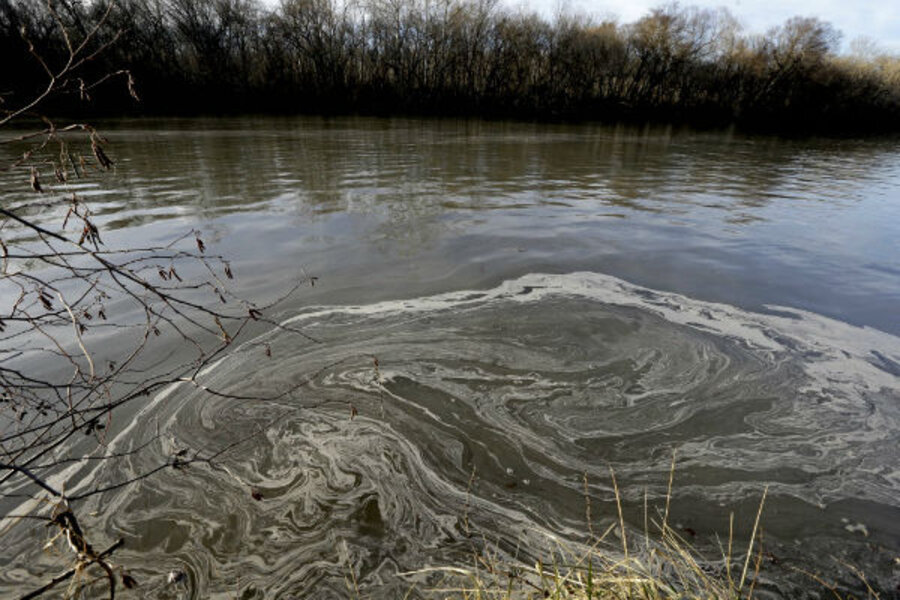Coal-ash spill: How certain that Dan River is safe for drinking, wildlife?
Loading...
Officials report that water from North Carolina's Dan River, sullied Feb. 2 when millions of gallons of sludge from a retired coal-fired power plant poured into the river, is safe to drink. Residents and environmentalists, however, aren't so sure, and some are conducting their own testing of water quality.
The contamination occurred when a storm pipe broke that runs underneath a Duke Energy coal ash basin. An estimated 50,000 to 80,000 tons of ash mixed with 24 million to 27 million gallons of water entered the pipe from the ash basin and flowed into the nearby Dan River, says Catherine Butler, a spokeswoman for Duke Energy.
“It’s just a heartbreak,” says Jenny Edwards, program manager for the Dan River Basin Association. “It’s a gut punch to see your river full of coal ash and not be able to do anything about it.”
Coal ash is a byproduct of the combustion of finely ground coal during electricity generation. At one time, the lightest ash particles, known as fly ash, vented into the atmosphere through smoke stacks. As a result of increased regulation of air pollution, coal-fired power plants began collecting the ash in filters and storing it onsite in designated ponds so it wouldn’t blow away in the wind. In this case, a dam separates the pond and the slurry of ash and water from entering the river. While the dam remains intact, the ruptured pipe created a new pathway for the sludge to enter the river.
On Feb. 3, the day after the rupture, the North Carolina Department of Environment and Natural Resources (NCDENR) recorded concentrations of arsenic in the river on the order of 40 micrograms per liter, above the 10 microgram-per-liter threshold for human health.
“The good news is that so far none of the downstream municipalities are reporting that their drinking water is contaminated,” says Jamie Kritzer, a spokesman for NCDENR.
The same cannot be said for the river's ecosystem.
“In all honesty, the numbers we’re seeing are of concern for the long-term health of that river and all of the species that rely on it,” Mr. Kritzer says.
Until now, the Dan River has been considered a swimable, fishable, and biologically healthy river, says Ms. Edwards of the Dan River Basin Association. Deer, raccoons, bald eagles, and herons frequented its banks, people fished for catfish, and children enjoyed swimming and tubing. How this spill will affect the health of the river’s ecosystems remains unknown.
Independent water analysis found elevated levels of arsenic, chromium, iron, and lead in samples collected near the spill site by Waterkeepers Alliance, a national environmental group founded by an environmental attorney and Robert F. Kennedy Jr. and based in New York.
“We’re very concerned because coal ash is highly toxic,” Edwards says. “We are really concerned about the impact it’s going to have on wildlife starting toward the bottom of the food chain, which is the macroinvertebrates, or the bugs.”
While the health of the river’s bugs may seem inconsequential, their survival plays a key role in the health of the entire ecosystem.
“Without those bugs in the river, no other life on the river is possible because those bugs feed the fish and the fish is, of course, what the heron and the bald eagle are hunting,” Edwards says.
Many metals accumulate in the bug and fish tissues. When a bird eats a fish that has eaten many contaminated bugs, that bird is also ingesting all of the metals that the bugs consumed. NCDENR will continue to examine sediments and fish tissues to determine if the river’s catfish will still be safe for human consumption.
For its part, Duke’s Butler says the company has been working closely with the Environmental Protection Agency and the state and national Fish and Wildlife departments to develop long-term assessment and remediation plans.
“We pledge to take care of the Dan River and the surrounding environment,” Butler says. “We continue to have crews here to address the incident and we are using all of the available resources to take care of the river. We’ll pursue whatever immediate steps we need to take at all of our ash basins.”
The spill occurred one month after a chemical used to wash coal leaked into West Virginia’s Elk River, contaminated the river, left 300,000 residents without access to drinking water for days, and raised new questions about the dangers posed by the coal industry to public health.
The irony of the Dan River spill is that the coal-fired power plant that produced the ash was retired on April 1, 2013, and is being transitioned to a combined cycle natural-gas plant. Duke is in the process of decommissioning the plant and determining the best way to dispose of the ash contained in the basin.
Duke Energy owns 14 coal-fired power plants in North Carolina, seven of which are in the process of being decommissioned. In the past year, local environmental groups have attempted to force Duke Energy to clear out leaky coal ash dumps.
“We are very committed to close the ash basin. We are trying to determine the method for this site at this point,” Butler says.
Currently the company is weighing three options: full excavation, which would include relocation of all the ash to a lined landfill; a cap in place, which involves covering the basin with a synthetic liner that would prevent water from entering the basin from above (the basin would remain unlined); or a hybrid method, which would include a partial excavation and then a cap in place.








